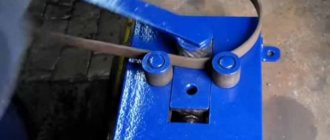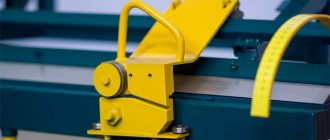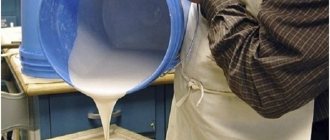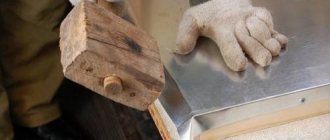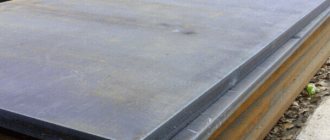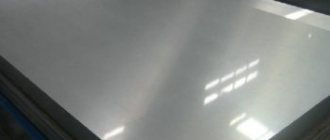Bending of metal workpieces is presented as a technological process, during which the workpiece can be given a specific configuration by compressing the internal and stretching the outer layers of the workpiece. Bending metal involves stretching the outer layers and increasing their size; the inner layers, on the contrary, decrease in size due to compression. Only the layers located along the axis of the workpiece remain unchanged.
The service in question in metal production is quite in demand and is one of the areas of activity of our company. Sheet metal bending in Moscow involves the absence of welding seams, which allows for a stronger and more durable final product.
Sheet metal bending: description of methods and technology
Metal bending is a special method of changing the shape of a preliminary workpiece. Metal deformation is carried out without sampling material, which involves cutting or electric welding of metal products.
Where is it used?
With the help of metal bending, you can give the workpiece any shape, using special equipment or carrying out the procedure manually. When carrying out this type of impact on a sheet of metal material, the following occurs:
- stretching the layers that are on the outside;
- compression of the inner layers of the workpiece.
In this way, it is possible to bend one of the sides of the workpiece to the desired angle relative to the other. The use of curved parts is wide; they are in demand in almost any field and area that uses structures made of metals and various alloys.
Metal bending occurs in the manufacture of:
- automotive elements;
- furniture designs;
- door structures;
- industrial parts.
The procedure is used in aviation, shipbuilding, and electronics. It is also in demand in the construction industry. Bending metal will require a lot of force, especially when it comes to changing the shape of thick products.
Despite its apparent simplicity, the technology is quite complex. It requires a responsible approach and certain experience.
Bending on CNC machines
The metalworking plant uses six CNC press brakes, varying in application and technical characteristics. Our equipment bends metal in strictly specified places, of a strictly specified length at a strictly specified angle, with high accuracy and reliability of the technological process for repetitions of a programmed bend.
- DURMAZLAR DURMA AD-S 220/4000
- VIMERCATI PHSY 150/3000
- SMD PBB 110/3100
- YANGLI WC67K 80/2500
- SMD WEN 40/2000
- Vimercati PHSY 15050
Thanks to our fleet of modern machine tools, a wide range of tools for press brakes, the experience and competence of our team, we are able to provide highly efficient productivity for orders of any volume and complexity!
Basic principles
When bending metal, it is necessary to take into account a number of principles, among which the following require special attention.
- The minimum bend radius must be greater than the thickness of the workpiece. This is the only way to prevent the formation of cracks and tears on the metal surface, which will allow you to stop the procedure in a timely manner and take measures to eliminate the defect.
- When performing work at home, it is recommended to bend thin-walled sheets, the thickness of which does not exceed 3-10 mm. This is explained by the fact that bending thick sheets requires the use of expensive professional equipment.
- Before carrying out work, it is necessary to calculate the development of the future product, take into account allowances, as well as the length of the working surface. It should not exceed 4 meters, otherwise it will not be possible to achieve an accurate result.
- As a material for a product that is subsequently planned to be deformed, it is recommended to give preference to ductile alloys. An excellent option would be iron sheets or elements that contain carbon impurities. You can view the grades of such steels in a special table.
- Heating increases the plasticity coefficient - this is a physical phenomenon. Sometimes, by heating, it will be possible to achieve the desired bending angle without mechanical damage. Increasing the temperature will prevent cracks on the metal surface.
- To carry out the work, you can use various tools, ranging from a vice for clamping a sheet to a special machine on which the main stage is carried out. They will help you bend smoothly and take allowances into account.
Bending sheet metal requires strength and patience as the process is slow due to the need to monitor the surface condition of the material.
Metal bending prices
| Thickness/Length (mm) | 100 | 200 | 500 | 1000 | 1500 | 2000 | 2500 | > 2500 |
| 0,5 | 12 rub. | 15 rub. | 20 rub. | 34 rub. | 45 rub. | 58 rub. | 70 rub. | 83 rub. |
| 1 | 12 rub. | 15 rub. | 21 rub. | 35 rub. | 45 rub. | 58 rub. | 70 rub. | 83 rub. |
| 2 | 12 rub. | 15 rub. | 21 rub. | 35 rub. | 48 rub. | 59 rub. | 72 rub. | 87 rub. |
| 2,5 | 12 rub. | 15 rub. | 23 rub. | 36 rub. | 51 rub. | 59 rub. | 72 rub. | 102 rub. |
| 3 | 12 rub. | 17 rub. | 23 rub. | 38 rub. | 57 rub. | 59 rub. | 87 rub. | 121 rub. |
| 4 | 15 rub. | 18 rub. | 25 rub. | 41 rub. | 67 rub. | 74 rub. | 111 rub. | 157 rub. |
| 5 | 16 rub. | 20 rub. | 27 rub. | 48 rub. | 76 rub. | 95 rub. | 143 rub. | 196 rub. |
| 6 | 17 rub. | 23 rub. | 30 rub. | 56 rub. | 90 rub. | 113 rub. | 170 rub. | 235 rub. |
| 8 | 19 rub. | 23 rub. | 36 rub. | 64 rub. | 111 rub. | 146 rub. | 221 rub. | 313 rub. |
| 10 | 21 rub. | 25 rub. | 41 rub. | 74 rub. | 115 rub. | 183 rub. | 278 rub. | 417 rub. |
| 12 | 23 rub. | 28 rub. | 45 rub. | 89 rub. | 129 rub. | 227 rub. | 409 rub. | 554 rub. |
| 14 | 26 rub. | 35 rub. | 49 rub. | 102 rub. | 170 rub. | 284 rub. | 488 rub. | 738 rub. |
| 16 | 33 rub. | 41 rub. | 57 rub. | 112 rub. | 261 rub. | 354 rub. | 586 rub. | 982 rub. |
Prices are indicated in rubles including VAT per 1 GB.
The ratio of bending radius / workpiece length / sheet thickness is agreed upon separately for the order. An increasing factor of 1.25 has been established for products made from customer-supplied metal. When calculating the cost of an order, the following system of discounts and surcharges is used: Minimum order amount is 3,500 rubles. All prices are indicated in rubles, including VAT 18%. Urgent order processing is possible - on the same day or the next day, the cost is calculated individually. It is advisable to provide development drawings or other documentation in DXF or AutoCAD format; if there is no documentation in these formats, we can help you develop them, the cost of preparing documentation is determined for each order individually, in some cases we can do this for free.
Types of bending
Metal bending is carried out in several ways, each of which deserves separate consideration. The use of a certain technology allows you to achieve the desired result in a short time and avoid severe deformation of the material.
Single corner
It is the simplest and most popular type of bending. When performing work, compression of the internal surfaces of the metal occurs. This is achieved by influencing the outer layers. In this case, the latter are stretched, which leads to the formation of a bend at the desired angle. This method is also known as free bending of metal blanks. A special feature is the simplicity of the design of the equipment used to carry out the procedure. It consists of:
- a matrix acting on the sheet in the process of bending the material;
- walls supporting the sheet during operation.
An air gap is provided between the walls and the sheet to prevent severe deformation of the products.
U-shaped
Used to create U-shaped parts. With its help, it is possible to speed up the production of elements, which is not possible with two-junction bending. At the same time, it is possible to increase the accuracy of the resulting products. The bending procedure involves the use of a punch, the operation of which leads to bending of the element. To straighten a part, calibration of the workpiece is required, during which additional stress redistribution occurs. This makes the springing of the part negligible. The method is in demand when working with parts of small thickness.
Radial
This type of bending is carried out using two types of equipment:
- manual;
- industrial.
Depending on what shape the product needs to be given, the design and types of machines change.
Radius bending is popular in many fields. It is used for the manufacture of various metal structures.
The result of such metalworking makes it possible to obtain a complex configuration without the use of welding devices and seams. Thus, the strength properties of the structure are preserved, and its appearance is not spoiled by welding. Bending technology is used in the manufacture of canopies, various boxes, special profiles, hanging facades and other structures that are used in everyday life and industry. The advantage of this method is that it can be done independently without the use of professional equipment.
Multi-angle
This version of metal bending allows you to form complex shapes. In this case, to create a structure, you can use either one element or several. The procedure is carried out using special equipment. It is also called faceted. Additionally, there are bending in the form of a cone, curved bending technology and other options.
Equipment used
There are two options for the bending process:
- using a manual sheet bender;
- using high-tech bending machines.
The first option is less popular due to the long duration of the process, the limited thickness of the metal being bent and the low quality of the resulting products. The process itself consists of a mechanical effect on the metal sheet, in which certain surfaces are stretched and compressed.
High-tech bending machines make it possible to process sheet metal on an industrial scale and create particularly complex products in large volumes and within a short period of time.
The SMART-STEEL company has a wide selection of tools not only for forming the simplest parts, but also for producing the most complex shapes with bends of different angles and shapes. For this purpose, a modern CNC sheet bending machine ERMAKSAN power bend 2600-100 was installed in the production. This is powerful equipment, designed for bending lengths up to 2600 mm, with a force of 100 tons.
The machine provides high speed of material processing and exceptional accuracy of bending angles. The device is equipped with a hydraulic press with a CNC system and a convenient color touch screen. There is also a graphic type display and other additional functional parts.
The main advantages of the machine include:
- a convenient control system in the form of a bright and contrasting touch display, large keys and a user-friendly interface;
- a wide range of options for calculating bends;
- automatic adjustment of successive bends;
- possibility of monitoring from a PC or laptop;
- compact design and much more.
High-quality equipment is quickly configured, easy to operate and operates smoothly. The use of computer-controlled machines is becoming a priority and is typical for enterprises of any size. The use of such equipment increases the speed of work, significantly saves metal and makes it possible to increase the accuracy of processing. It is especially important that products can be produced uninterruptedly around the clock without the involvement of additional labor, which takes production to a fundamentally new level.
How to bend a sheet at home?
In the process of building a house, cottage or other structures, the need arises to equip various structures and products. For example, when making gutters, metal frames, and canopies, it is necessary to give a flat piece, which is a sheet of metal, the required shape. There are several options for how you can bend a metal sheet with your own hands.
Using a sheet bender
Sheet bending is special equipment, through the use of which it is possible to give an aluminum or iron sheet the desired configuration. If desired, the unit can be made independently. To do this you need to prepare:
- bed;
- a beam designed to create clamping force;
- beam for organizing rotation;
- crimp beam;
- galvanized knives;
- receiving tray, the material for which is wood or metal.
When creating a machine, you should pay attention that the device will be controlled by muscle force. Therefore, the device is intended only for thin sheet metal, the thickness of which does not exceed 2 mm. To make a base for the machine, you will need to use small quantities of profiled metal. It is enough to stock up on a channel or a metal beam with a cross section in the form of an I-beam.
During assembly, it is necessary to take into account the required structural rigidity parameters, otherwise the equipment will not cope with the task and will quickly fail. In addition, the quality of the processing depends on the hardness index. The clamping device is made of steel plates. A homemade machine makes it possible to bend profile products. An excellent option would be to choose channel No. 12. To assemble the structure, you can use tongs and pliers.
Useful tips
The success of steel bending depends on their ductility. In the case of low-plasticity materials, the procedure becomes more complicated. The reason is the phenomenon of springing, which implies a discrepancy between the shape of the finished part and the requirements of the drawing. This phenomenon is the main problem faced by everyone who decides to resort to metal bending.
The essence of springing is the elastic action of a metal sheet or other workpiece immediately after the load is removed. The result of this phenomenon is a distorted shape of the product. Sometimes the spring angle reaches high levels, which is unpleasant. The phenomenon can be eliminated by using the following techniques.
- Angle compensation by changing the parameters of the working part of the equipment. The method is effective, but only if the brand of the metal sheet is known, as well as the main characteristics of the product. It is especially important to pay attention to the tensile strength limit, on which the springback index of the structure depends. The procedure is quite simple to use: if the deformation angle is, for example, 100, then the edge of the press is increased by this figure.
- Changing the main profile provided in the matrix. Due to such actions, it is possible to achieve bending of the workpiece along the entire length of the zone in which deformation occurs, using a working tool. Additionally, special recesses are provided in the matrix.
- Increasing the plasticity index of the workpiece. To do this, the metal is fired at high temperatures. It is worth considering that the type of steel depends on the firing temperature, so it is recommended to clarify the composition and brand of the product in advance.
- Carrying out bending in a heated state. In this case, the plastic characteristics of the metal are improved, which allows you to get rid of the springing effect and achieve the desired bend angle.
Regarding the last option, it is worth noting that the technological process will require additional cleaning of the surface of the working part. You will also need to constantly clean the surface of the matrix, on which scale will accumulate.
Sheet metal bending is a complex procedure that allows you to achieve the desired shape of a metal sheet and at the same time avoid the deformation that welding provides. To obtain the desired workpiece configuration, you should take into account the characteristics of the material and provide options that will help avoid the formation of cracks or the occurrence of a springback effect.
See below for more details.
Sheet metal bending technology
The process is carried out using special equipment in which the source material is firmly fixed. Bending occurs as a result of the action of the press located above. The technology itself is extremely simple, but it makes it possible to create metal structures of any complexity. Modern equipment ensures high manufacturing precision, aesthetic appearance of the resulting parts and long service life due to their integrity.
The bending process itself consists of three main stages:
- elastic tension;
- neutral state;
- plastic tension.
To exclude the possibility of a defective issue, certain points should be taken into account:
- direction of the fibers of the fabric being processed;
- thickness of the workpiece, allowing for a certain complexity and intensity of deformation;
- level of material fluidity;
- level of bending accuracy relative to the specified parameters.
If you strictly follow all the rules, the possibility of producing a defect will be minimal.
The bending process itself is based on the interaction of three main points. The original canvas rests on two points. There is pressure on the third point, and it goes down along with the press. At the point of pressure, compression of the material occurs, and on the outside, tension occurs. At each bend, the workpiece elongates, and its deformation depends on the composition of the web, its thickness, bending angle and radius. To achieve accuracy in obtaining a part, it is worth focusing on the possible difference in the resulting dimensions during deformation. It should be understood that complex deformations will require the greatest application of force. The SMART-STYLE company carries out orders for bending sheet metal of particular complexity, including radius options. For high-quality radius bending, it is necessary to select the correct linear size of the original sheet. When designing, it is always taken into account that the length of the prepared sheet will differ from the finished product. The specificity of radius bending is such that during deformation, the inner layer of metal is compressed, and the outer one is stretched. Therefore, before radius bending, the entire geometry of the workpiece is carefully calculated. The bending radius of a metal sheet is usually calculated using special engineering tables.
